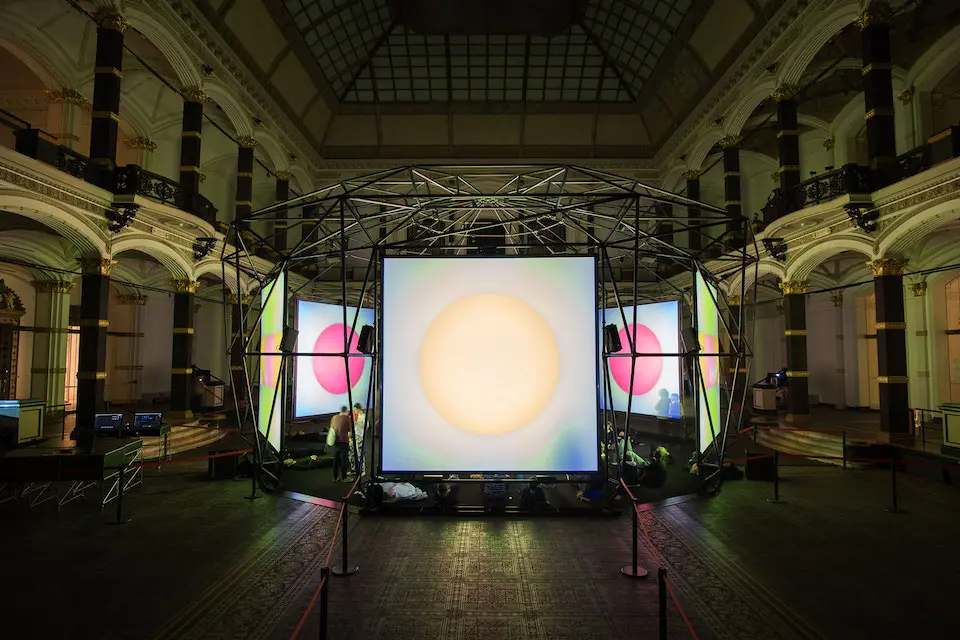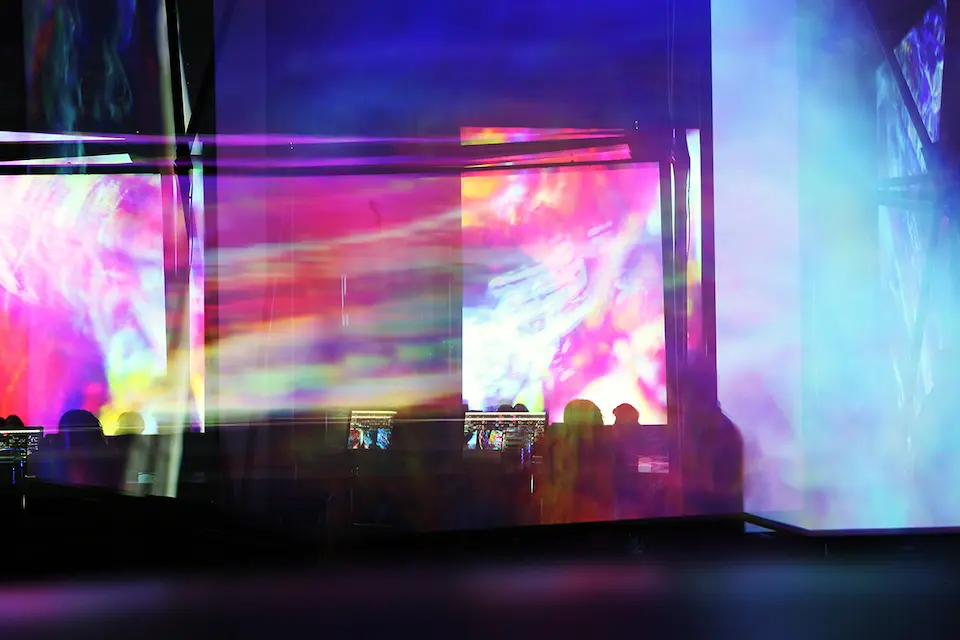
Turning immersive art into a shared experience at the Institute for Sound & Music
Published on January 15, 2021
"It's about the world of art and its intersection with music and sound and science and technology. "
For decades, audiophiles have tried to invent new ways of making the listening experience more immersive. But the evolution from mono to stereo to surround sound to noise-canceling headphones proves some can never get too deep into the experience of sound.
Right now, immersive entertainment is often synonymous with virtual reality. The problem is, no matter how entranced you get, the bulky headsets are an uncomfortable reminder that you’re still fundamentally disconnected—from the physical world and from other people.
The Institute for Sound & Music has a better idea.
Founded in Berlin in 2017 by Nicholas Meehan, Ben Fawkes, and Brendan Power, ISM is a non-profit with an ambitious mission: To demonstrate the cultural impact of sound by building a museum where people can immerse themselves in cutting-edge art installations.
Over the past three years, ISM has been collaborating with influential musicians, including Brian Eno, Thom Yorke, and Holly Herndon, to produce extraordinary exhibitions that showcase what’s possible when you combine vanguard artistic concepts with emerging technology.
But when the pandemic forced the cancellation of major events like SXSW—where ISM was scheduled to bring their Hexadome—the team had to quickly adapt to a new landscape for live entertainment and adjust to life as a fully distributed team. To find how they pivoted their plans and kept their vibrant work alive, we spoke with Ben Fawkes, Vice Chairman at ISM.
"Not only were you experiencing the movement of the visuals, you're also experiencing the architecture of the room you're in."
DBX: Could you describe what visitors see and hear?
BEN FAWKES: We built the sound system based on the technology from an institution in Karlsruhe called the ZKM. They're a Digital Media Research Center. Over the last 10 years, their sound department developed a thing called the Klangdom, which is basically a spatialized sound system.
The idea is that you could, in theory, play 52 sounds via 52 channels. The Klangdom provides you with a way to move sounds in various different ways. The speakers are arranged from all the way to the top of the Hexadome structure all the way to the bottom.
The way we presented it with the Klangdom sound system in the Hexadome, no matter where you are in that space, you essentially have the same experience, you feel the spatialization, you feel the movement exactly the same. For the visual element of the Hexadome experience, we partnered with Berlin-based design and motion graphics studio Pfadfinderei. They came up with the hexagonal shape as it allowed for windows into the artistic experience but also the opportunity for the visitors to freely walk in and out of the space.
It also allows you to have an experience of the larger room that the Hexadome sits in, which adds to the experience, particularly if you're presenting in a museum. At the Gropius Bau, we presented in the atrium, which had a glass ceiling and a mezzanine.

So being able to have those spaces and that negative space in between the screens meant that not only were you experiencing the movement of the visuals, you're also experiencing the architecture of the room you're in. From a very logistical, people-management perspective, it meant that people could come and go quite easily as well.
Was it originally conceived to be a mobile structure? Did you have the idea of taking it on tour from the beginning?
The Hexadome is one of many exhibitions we're trying to develop to help explain this long term goal of building a museum for sound. The Hexadome is our first achievement of delivering and presenting the kind of content we would make in this space. But yes, it was always at the back of our minds that it could be a tour-able exhibition. Since we presented it in Berlin, we have toured the exhibition in San Francisco during Gray Area Festival, Montreal for Mutek Festival and also at the amazing MASS MoCA in Massachussetts. We have plans for present it in 2021 also.
A lot of new music is now first heard on our phones or in cars instead of through speakers in a room at home. Was ISM created to address changes in the way we experience recorded music?
I don't think it's a reaction to the way we consume music. It's more reaction to what else can be done in the world of music, and being a facilitator and a platform for experimenting and innovating in that space. There is definitely a bit of a reaction to the need to provide a space and experiences that people can share together.
We often talk about shared experience. In the world we live in today, particularly with so many screens and the habits in work and the busyness of modern life, we want to provide a platform for artists to create things people can experience together in the real world. So it's not a reaction to anything about the music industry. It's more about “Where else could the music and artistic world can go together?” It's about the world of art and its intersection with music and sound and science and technology.
How did your team work together in development of the Hexadome or the museum?
A lot of it is online collaboration. We all work voluntarily, so to get everyone in a room at the same time is big challenge. Being able to use things like Dropbox with the ISM Hexadome at SXSW, we have all of our communication and technical information and press photos— all of the stuff we need to deliver to people at Paramount or press partners—they're all located on Dropbox. It's the same when it comes to anything that we do. If our guys have new videos for promotional work, they'll share them on Dropbox or will link to them on Slack. My colleague Martin does our website. He often will manage everything when it comes to the visual communications side by ordering and filing all that documentation on Dropbox and online. So it's very important for us to be able to collaborate in that way.
“Everything from project managing the creative side…to the boring stuff like accounting is all done on Dropbox.”
With this North American tour that we did with the ISM Hexadome, which was funded by the Goethe-Institut and the German Foreign Office as part of the year of German American friendship. At the end of it, we had to do all the financial accounting reporting. Being able to take photos of all of the receipts and all of the printed out documentation, my colleague was telling me “Dropbox is great because you can take a photo and then it just gets put into a file, then our accountant that’s sitting somewhere else was able to go into that file and check that it corresponded to the invoice online and budget.” Everything from project managing the creative side, where we're working on other other exhibitions, and uploading ideas and renderings of those all the way to the boring stuff like accounting, is all done on Dropbox.
After the pandemic forced the cancellation of major events like SXSW, how did you adapt and begin rethinking the rest of 2020?
Well, it gave us more time to think about new exhibitions and projects for the future. It also made us think about what we can do online, think how we can do digital exhibitions and how we can focus on engaging with the local community. We've tried to make the best out of the situation because the one thing it's given us all is more time to think and deliberate.
Did the lockdown order change any of your work habits?
It's changed all our work habits, really. We would often meet in person in our office, this slowed down dramatically when the lockdown arrived. We've moved more to Zoom meetings, more phone calls and communicating through Slack and online docs through Dropbox.
Have you been redesigning with new safety precautions in mind to allow for social distancing?
The beauty of the Hexadome is that it's a large open space that can handle a lot of people at one time, or be controlled with a limited capacity. If and when we present the Hexadome again we'll be able to take social distancing into consideration quite easily and simply control the amount of people that get to experience it at one time. Also, we are working on some concepts that will be presented digitally first.
How has this extended period of isolation affected your ability to stay motivated and focused?
I can only speak for myself here, but the isolation came at a time where I was able to be incredibly productive with little distraction. As the year has evolved and the isolation has dragged on, it has been harder to remain motivated. But at the start, it enabled me to dive in without distraction. Now it's a case of being sure to take care of yourself, take breaks, do exercise—and actually schedule it in—and also proactively phone friends and colleagues to check in. As a team of volunteers working on this project along with our day jobs, our working structure and style is often online using Slack, Dropbox, Zoom, and email to keep things moving.

What’s next for the ISM team?
We recently launched the ISM Supporter Program. Donations over €40 will receive The ISM HEXADOME Listening Experience, a limited edition vinyl set featuring binaural recordings from the physical ISM Hexadome installation at MASS MoCA, Massachusetts Museum of Contemporary Art. The set includes eight live installation recordings pressed onto four 12" vinyl records with contributions from Suzanne Ciani, Ben Frost, Frank Bretschneider, Peter van Hoesen, Lara Sarkissian, CAO, Herman Kolgen, and René Löwe.
In 2021, ISM will begin to present ways in which sound and music can be a vehicle for change. And we’ll explore the potential and possibility of a new center, or physical home, for sound, immersive art, and electronic music culture in Berlin.
To learn more about the Institute for Sound & Music, check out berlin-ism.com.



